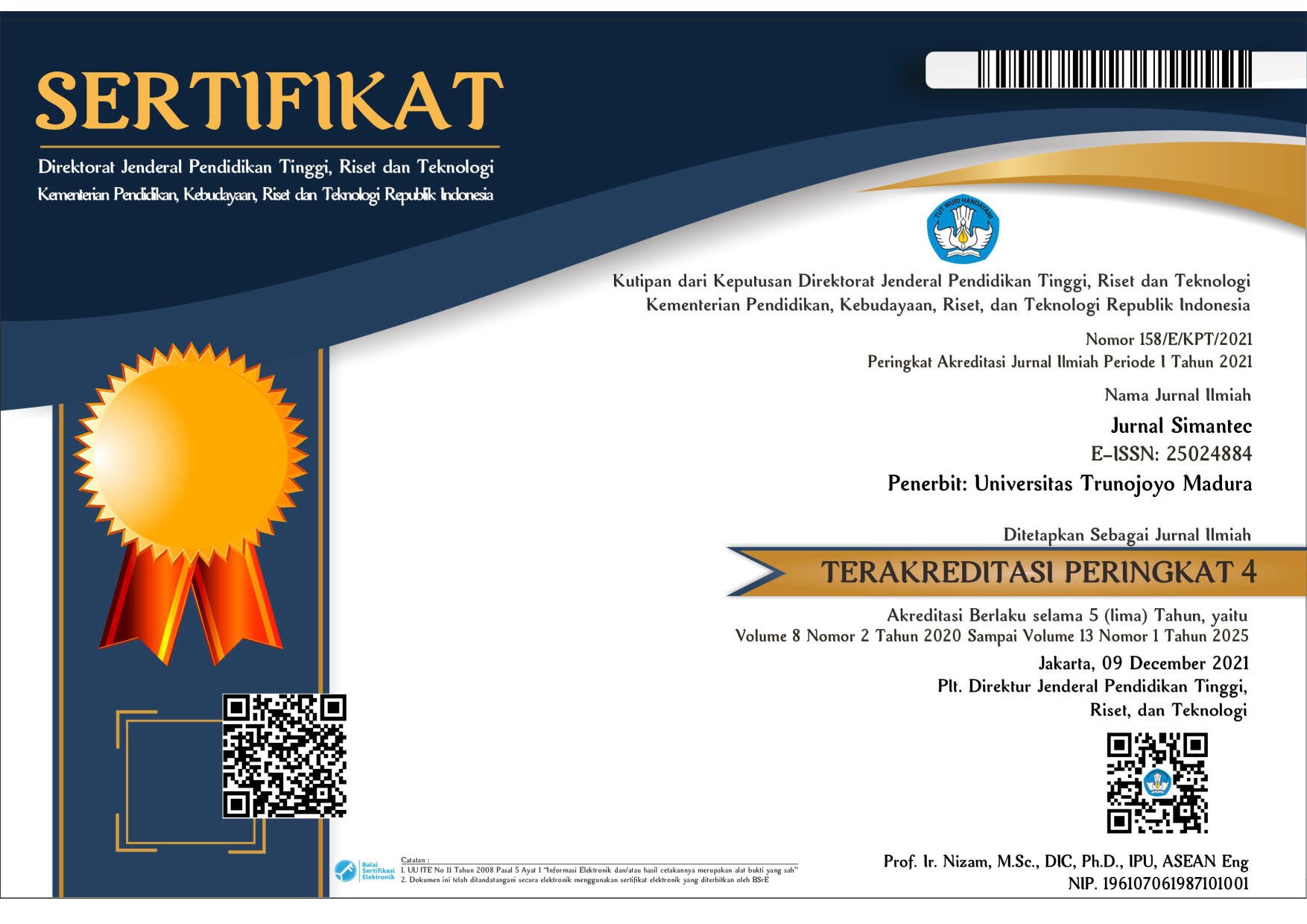MRI image enhancement of the brain using U-NET
Abstract
The quality of Magnetic Resonance Imaging (MRI) images is often compromised by various types of noise, such as salt, pepper, salt-and-pepper, and speckle noise, caused by technical or environmental disturbances. This study aims to develop a brain MRI image denoising model based on the U-Net architecture, capable of effectively removing different types of noise. The methodology includes collecting normal brain MRI datasets, applying data augmentation to increase variability, and introducing artificial noise to simulate possible noise conditions. The U-Net model is trained and evaluated using the Mean Squared Error (MSE) and Peak Signal-to-Noise Ratio (PSNR) metrics. The novelty of this study lies in its combination of augmentation techniques, multi-intensity artificial noise variations, and its exclusive focus on normal brain MRI images. The results demonstrate that the U-Net model achieves optimal performance on salt-and-pepper noise at an intensity of 0.1, marked by the highest PSNR value of 37.2047 dB and the lowest MSE value of 0.000207. Conversely, the model shows the lowest performance on high-intensity speckle noise, indicating greater challenges in addressing multiplicative noise. This study contributes a systematic and empirically tested approach to improving the quality of brain MRI images with high efficiency, supporting the development of image-based diagnostic systems in the medical field.
Keywords: Deep Learning, Denoising, Image Enhancement, Noise, U-Net.Full Text:
PDFReferences
B. Nouri, M. Arab, and M. Nasiri, “Endometriosis: Clinical, Magnetic Resonance Imaging and Pathologic Findings,” J. Obstet. Gynecol. Cancer Res., vol. 8, no. 5, pp. 481–487, Sep. 2023, doi: 10.30699/jogcr.8.5.481. https://doi.org/10.30699/jogcr.8.5.481
D. Tamada, “Review: Noise and artifact reduction for MRI using deep learning,” Feb. 2020, [Online]. Available: http://arxiv.org/abs/2002.12889 https://doi.org/10.48550/arXiv.2002.12889
A. Makhlouf, M. Maayah, N. Abughanam, and C. Catal, “The use of generative adversarial networks in medical image augmentation,” Neural Comput. Appl., vol. 35, no. 34, pp. 24055–24068, Dec. 2023, doi: 10.1007/s00521-023-09100-z. https://doi.org/10.1007/s00521-023-09100-z
N. Mamatov, K. Erejepov, M. Jalelova, I. Narzullayev, and A. Samijonov, “X-ray Image Contrast Enhancement Approach,” in 2024 3rd International Conference on Applied Artificial Intelligence and Computing (ICAAIC), IEEE, Jun. 2024, pp. 1293–1297. doi: 10.1109/ICAAIC60222.2024.10575386. https://doi.org/10.1109/ICAAIC60222.2024.10575386
A. Z. - and H. N. -, “A Study on Image Noise Removal Techniques for Magnetic Resonance Imaging,” Int. J. Multidiscip. Res., vol. 6, no. 1, Feb. 2024, doi: 10.36948/ijfmr.2024.v06i01.13298. https://doi.org/10.36948/ijfmr.2024.v06i01.13298
A. Thomas, D. K. K R, D. Babu, and A. P.E, “Denoising Autoencoder for the Removal of Noise in Brain MR Images,” in 2023 International Conference on Control, Communication and Computing (ICCC), IEEE, May 2023, pp. 1–5. doi: 10.1109/ICCC57789.2023.10165274. https://doi.org/10.1109/ICCC57789.2023.10165274
M. Tripathi, “Facial image denoising using Autoencoder and UNET,” Herit. Sustain. Dev., vol. 3, no. 2, pp. 89–96, 2021, doi: 10.37868/hsd.v3i2.71. https://doi.org/10.37868/hsd.v3i2.71
S.-H. Kang and Y. Lee, “Motion Artifact Reduction Using U-Net Model with Three-Dimensional Simulation-Based Datasets for Brain Magnetic Resonance Images,” Bioengineering, vol. 11, no. 3, p. 227, Feb. 2024, doi: 10.3390/bioengineering11030227. https://doi.org/10.3390/bioengineering11030227
Y. Gi et al., “Study of multistep Dense U‐Net‐based automatic segmentation for head MRI scans,” Med. Phys., vol. 51, no. 3, pp. 2230–2238, Mar. 2024, doi: 10.1002/mp.16824. https://doi.org/10.1002/mp.16824
R. Touati, W. Trung Le, and S. Kadoury, “Multi-planar dual adversarial network based on dynamic 3D features for MRI-CT head and neck image synthesis,” Phys. Med. Biol., vol. 69, no. 15, p. 155012, Aug. 2024, doi: 10.1088/1361-6560/ad611a. https://doi.org/10.1088/1361-6560/ad611a
K.-J. Tsai, C.-C. Chang, L.-C. Lo, J. Y. Chiang, C.-S. Chang, and Y.-J. Huang, “Automatic segmentation of paravertebral muscles in abdominal CT scan by U-Net,” Medicine (Baltimore)., vol. 100, no. 44, p. e27649, Nov. 2021, doi: 10.1097/MD.0000000000027649. https://doi.org/10.1097/MD.0000000000027649
M. Nishio, S. Noguchi, and K. Fujimoto, “Automatic Pancreas Segmentation Using Coarse-Scaled 2D Model of Deep Learning: Usefulness of Data Augmentation and Deep U-Net,” Appl. Sci., vol. 10, no. 10, p. 3360, May 2020, doi: 10.3390/app10103360. https://doi.org/10.3390/app10103360
O. Rainio and R. Klén, “Comparison of simple augmentation transformations for a convolutional neural network classifying medical images,” Signal, Image Video Process., vol. 18, no. 4, pp. 3353–3360, 2024, doi: 10.1007/s11760-024-02998-5. https://doi.org/10.1007/s11760-024-02998-5
D. Azcona, K. McGuinness, and A. F. Smeaton, “A Comparative Study of Existing and New Deep Learning Methods for Detecting Knee Injuries using the MRNet Dataset,” in 2020 International Conference on Intelligent Data Science Technologies and Applications (IDSTA), IEEE, Oct. 2020, pp. 149–155. doi: 10.1109/IDSTA50958.2020.9264030. https://doi.org/10.1109/IDSTA50958.2020.9264030
W. Wu, M. Chen, Y. Xiang, Y. Zhang, and Y. Yang, “Recent progress in image denoising: A training strategy perspective,” IET Image Process., vol. 17, no. 6, pp. 1627–1657, May 2023, doi: 10.1049/ipr2.12748. https://doi.org/10.1049/ipr2.12748
S. S. Hidayat, D. Rahmawati, M. C. A. Prabowo, L. Triyono, and F. T. Putri, “Determining the Rice Seeds Quality Using Convolutional Neural Network,” JOIV Int. J. Informatics Vis., vol. 7, no. 2, p. 527, Jun. 2023, doi: 10.30630/joiv.7.2.1175. https://doi.org/10.30630/joiv.7.2.1175
T. Ashwin B. and B. Amma N. G., “Comparative Analysis of Machine learning Techniques for Classifying the Risk of Cardiovascular Diseases,” 2024, pp. 161–186. doi: 10.4018/979-8-3693-0683-3.ch009. https://doi.org/10.4018/979-8-3693-0683-3.ch009
K. Ali, A. N. Qureshi, M. Shahid Bhatti, A. Sohail, M. Hijji, and A. Saeed, “De-Noising Brain MRI Images by Mixing Concatenation and Residual Learning (MCR),” Comput. Syst. Sci. Eng., vol. 45, no. 2, pp. 1167–1186, 2023, doi: 10.32604/csse.2023.032508. https://doi.org/10.32604/csse.2023.032508
X. Wang, Y. Hua, E. Kodirov, D. A. Clifton, and N. M. Robertson, “IMAE for Noise-Robust Learning: Mean Absolute Error Does Not Treat Examples Equally and Gradient Magnitude’s Variance Matters,” pp. 1–19, 2019, [Online]. Available:http://arxiv.org/abs/1903.12141-https://doi.org/10.48550/arXiv.1903.12141
J. Gurrola-Ramos, O. Dalmau, and T. E. Alarcon, “A Residual Dense U-Net Neural Network for Image Denoising,” IEEE Access, vol. 9, pp. 31742–31754, 2021, doi: 10.1109/ACCESS.2021.3061062. https://doi.org/10.1109/ACCESS.2021.3061062
S. A. Naji and N. Majeed Saleh, “Digital Image Forgery Detection And Localization Using The Innovated U-Net,” Iraqi J. Comput. Informatics, vol. 50, no. 1, pp. 195–207, Jun. 2024, doi: 10.25195/ijci.v50i1.484. https://doi.org/10.25195/ijci.v50i1.484
X. Li, H. Chen, D. Zheng, and X. Xu, “CED-Net: A more effective DenseNet model with channel enhancement,” Math. Biosci. Eng., vol. 19, no. 12, pp. 12232–12246, 2022, doi: 10.3934/mbe.2022569. https://doi.org/10.3934/mbe.2022569
Y. Cui, X. Hong, H. Yang, Z. Ge, and J. Jiang, “AsymUNet: An Efficient Multi-Layer Perceptron Model Based on Asymmetric U-Net for Medical Image Noise Removal,” Electronics, vol. 13, no. 16, p. 3191, Aug. 2024, doi: 10.3390/electronics13163191. https://doi.org/10.3390/electronics13163191
W. El-Shafai et al., “Efficient deep-learning-based Autoencoder denoising approach for medical image diagnosis,” Comput. Mater. Contin., vol. 70, no. 3, pp. 6107–6125, 2022, doi: 10.32604/cmc.2022.020698. https://doi.org/10.32604/cmc.2022.020698
L. Kong et al., “A Generalized Deep Learning Method for Synthetic CT Generation,” Int. J. Radiat. Oncol., vol. 117, no. 2, p. e472, Oct. 2023, doi: 10.1016/j.ijrobp.2023.06.1681. https://doi.org/10.1016/j.ijrobp.2023.06.1681
Y. FAROOQ and S. SAVAŞ, “Noise Removal from the Image Using Convolutional Neural Networks-Based Denoising Auto Encoder,” J. Emerg. Comput. Technol., vol. 3, no. 1, pp. 21–28, 2024, doi: 10.57020/ject.1390428. https://doi.org/10.57020/ject.1390428
Patrisius Batarius, Alfry Aristo Sinlae, and Elisabeth F. Fahik, “Analysis of the Quality of Natural Dyes in Weaving Exposed to Sunlight Using MSE and PSNR Parameters,” J. RESTI (Rekayasa Sist. dan Teknol. Informasi), vol. 6, no. 5, pp. 797–802, Oct. 2022, doi: 10.29207/resti.v6i5.4339. https://doi.org/10.29207/resti.v6i5.4339
Y. Y. Al-Aboosi, R. S. Issa, and A. Khalid Jassim, “Image denosing in underwater acoustic noise using discrete wavelet transform with different noise level estimation,” Telkomnika (Telecommunication Comput. Electron. Control., vol. 18, no. 3, pp. 1439–1446, 2020, doi: 10.12928/TELKOMNIKA.V18I3.14381. https://doi.org/10.12928/telkomnika.v18i3.14381
DOI: https://doi.org/10.21107/simantec.v13i2.29775
Refbacks
- There are currently no refbacks.
Copyright (c) 2025 I Gede Susrama Mas Diyasa
Indexed By
.png)

11.png)













